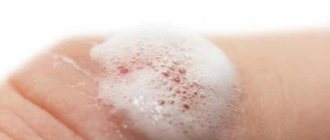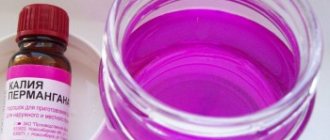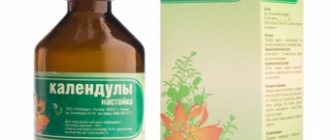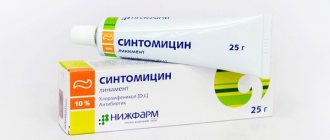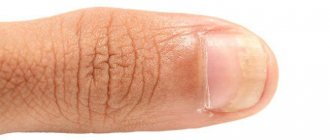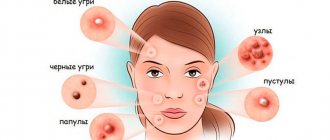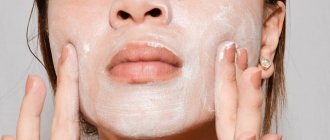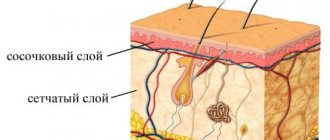The appearance of acne on the face is a very unpleasant circumstance that you have to deal with. The choice of products on the cosmetology and pharmaceutical market is huge, and sometimes it is difficult to decide which inexpensive drug will be most effective. Among all the variety, an affordable acne remedy stands out - hydrogen peroxide.
What is post-acne
Acne can appear on the face and neck, in the interscapular area, on the back and in the upper chest. Acne or acne is the formation of inflammatory elements on the skin - compacted reddened tubercles (papules) and blackheads, purulent white heads with redness around them. If elements are injured, squeezed out or heal poorly, post-inflammatory, scarring, and pigmentary changes form on the skin - this is post-acne.
This is what post-acne looks like
General characteristics of the product
Hydrogen peroxide is known for its antiseptic properties. It is used to cleanse wounds of pus, blood residues and as an antiseptic. However, peroxide has been experimentally shown to prolong the healing period of wounds. This happens because the skin cells adjacent to the wound are damaged by the solution. This in turn can contribute to scar formation. In addition, the solution has a bactericidal effect not only against pathogenic flora. It also destroys beneficial inhabitants of the skin, which can cause a violation of local immunity.
Conclusion: peroxide is considered to be an “ambulance” in the treatment of acne, but is not an acceptable remedy for long-term use.
Reasons for the appearance and areas of localization of post-acne
The skin is the largest organ in the human body, and it has a complex structure. In addition to the epithelial cells that form the continuous skin, there are also hair follicles, sweat and sebaceous glands. It is the glands that secrete sebum and form a protective hydrolipidic mantle on the surface of the epithelium that suffer during the development of acne.
To begin with, it is important to understand why acne occurs. When the sebaceous glands malfunction, the epithelium in the area of the ducts thickens, the lumen of the gland narrows and sebum cannot be regularly and fully released through the pores to the surface. Then the fatty secretion is retained inside the gland duct itself, which provokes inflammation with the participation of microbes that are constantly present on the surface of the skin, making up its microflora.
The process of acne formation goes through certain stages:
Initially, comedones are formed - an increase in the size of the sebaceous gland. Nodules form in the skin with an irritated opening of the sebaceous gland. As the process develops, black dots form in the center, and disturbances in the outflow of sebum, microbial activity, and the work of leukocytes during inflammation lead to the formation of purulent heads (pustules).
By themselves, these elements can leave behind scars and uneven skin, and if they are further injured, if you squeeze out blackheads or purulent heads, the inflammation only intensifies, and the purulent contents can spread to neighboring areas of the skin.
To prevent inflammation from spreading, to prevent damage to more and more areas of tissue, and to prevent pus from penetrating into neighboring areas, inflammatory changes form around the damage to the sebaceous gland.
Swelling occurs in the area of the pimple, collagen production is stimulated, scar changes are formed: connective tissue elements are formed, new capillaries grow, which gives redness, the work of pigment cells is stimulated - pigment spots are formed - persistent and with uneven edges.
Especially often, problems arise on the face, mainly in the forehead, on the nose and cheeks, on the chest, they also appear in the décolleté or on the back.
Redness disappears over time, pigmentation becomes less bright, scars can atrophy, forming dimples, or, conversely, become convex and rough.
Wipe your face with hydrogen peroxide: benefits and harms
If you regularly wipe your face with hydrogen peroxide, you will notice the following effect:
- Facial hair becomes lighter and becomes difficult to notice. Therefore, lightening facial hair with hydrogen peroxide is quite effective.
- Lightens freckles, acne spots and age spots.
- Elimination of the inflammatory process. This helps reduce the number of breakouts on your face.
- Drying out acne. They disappear faster and leave no traces.
- Saturation of cells with oxygen .
- Destruction of pathogenic microorganisms.
- Elimination of dead cells.
- Improved blood circulation.
It is important not to overdo it
Despite the large number of advantages, hydrogen peroxide for the face also has disadvantages. Among them:
- There is a high probability of triggering an allergy.
- Possible burns on the skin.
- Not suitable for dry and sensitive skin.
Before you start using peroxide, do a test for allergic reactions. Apply a little product to your wrist and wait a few hours. If redness or rashes do not appear, then you can use peroxide to improve the condition of the skin. If an allergy appears, then the use of the product should be abandoned.
Side effects
If you wipe your face with hydrogen peroxide in unlimited quantities, you risk causing the following side effects:
- Stomach upset, which manifests itself in the form of nausea and vomiting.
- The appearance of skin rashes.
- Sleep problems (insomnia, nightmares).
- Neuroses.
Types and stages of post-acne
Among the main signs of post-acne, hyperpigmentation is identified - these are areas of normally colored and darker skin, alternating with each other and forming an uneven tone.
In addition, the typical presence of stagnant red spots, enlarged skin pores, often filled with sebum, as well as pathological scars. In the area of blockage of the sebaceous glands, atheromas (sebaceous gland cysts filled with fatty secretions) or milia (whiteheads) are formed.
The main sign of post-acne is old cicatricial changes, scars after healed purulent acne. They can take three forms:
- depressed areas of skin, dimples (or atrophic scars);
- convex, lumpy areas, often with areas of erythema (hypertrophic);
- areas of dyschromia (the surface of the skin is spotty, with areas of increased pigmentation).
Sometimes the formation of keloid scars is mistakenly added to the classification. This is the wrong approach. People with a hereditary predisposition to the formation of rough and poorly healing scars that disfigure the appearance do not often suffer from acne, and therefore post-acne phenomena are rare for them.
The most common type of post-acne is the appearance of atrophic scars. According to the Jacob CI classification, they can take the form of rounded, chipped and square elements. This division helps doctors plan treatment and predict its results.
Round scars are the shallowest, and the prognosis for them is the most favorable. The square ones are somewhat deeper, but are also eliminated quite well. The biggest problem is the chipped forms of post-acne, they look like the Latin letter “V”, their bottom is located deep in the dermis.
Types of skin damage from acne
Compound
The drug is supplied to pharmacy counters with a 3% concentration of the active substance. The composition is simple. The main component is hydrogen peroxide. Auxiliary – specialized water and sodium benzoate.
For retail sale, packages of 40 and 100 ml are available, packaged in:
- Medicine bottles;
- Glass bubbles;
- Dropper bottles.
Hospitals receive 0.5 and 1 liter bottles.
Ways to get rid of post-acne
The intensity of post-acne is directly related to the severity of acne. Therefore, it is important to work not only to eliminate the consequences, but also to prevent the appearance of new elements on the skin. It is necessary to fight acne itself, eliminating its main causes. If pimples appear again and again, the prognosis for post-acne treatment is questionable; inflammation will give rise to new scars. Therefore, work with an experienced dermatologist-cosmetologist is required.
Most of the work on restoring, smoothing the skin and eliminating scars is carried out by a cosmetologist, but certain activities can also be performed at home. Moreover, only an integrated approach will give the most maximum results.
What can you do at home?
At home, you need to help the skin recover; it needs building elements and proper nutrition. To regenerate the skin and form its structure, it is necessary to supply vitamins and minerals, protein as a source of amino acids for the construction of collagen fibers and the synthesis of hyaluronic acid, which moisturizes and gives the skin tone and smoothness.
In addition, omega acids are important, which are involved in cell renewal and form cell membranes. It is important to adjust your diet, eliminate as much processed foods as possible, food chemicals (dyes, preservatives, E-additives) and give up bad habits.
To prevent new acne and improve tone, nourish the skin, heal inflammation and small scars, pharmaceutical products will help. You can use 1% salicylic alcohol or boric acid and wipe the skin with it twice a day. Levomekol ointment works quite well in treating acne, suppressing inflammation and eliminating scars. Many people use bodyaga powder, which is diluted in water to a paste and applied to the affected area. But before using all these remedies, it is important to first consult with your doctor to prevent side effects and complications.
Skin care is complemented by serums, care creams (day and night) selected by a cosmetologist, as well as homemade peelings with fruit acids. They delicately exfoliate the skin, remove dead cells, and cleanse its surface.
Folk remedies are often used, for example, infusions of St. John's wort and chamomile, which have an anti-inflammatory, soothing, cleansing effect. You can freeze them and wipe the skin with the resulting ice cubes, further increasing blood circulation and capillary tone.
You can also use masks with blue clay. The recipe for making a mask is very simple: three tablespoons of powder are diluted in water to a paste, applied to the problem area for 20 minutes and then thoroughly washed off with water.
What treatment methods are used in a cosmetology clinic?
Although homemade recipes help in the fight against post-acne, you should not think that only through them you can eliminate all problems. Home methods act on the very top layers of the skin and reduce only minor defects.
Modern cosmetic procedures will help get rid of deep scars, pigmentation and unevenness. But don't expect instant results.
Treatment methods are selected individually and comprehensively. The more severe the initial problem and the wider the affected area, the longer the treatment will be.
To achieve maximum smoothness of the skin and an even complexion or eliminate blemishes on the body, you need a whole series of procedures, supplemented by home care and carefully selected cosmetics. On average, the first noticeable results will be visible after 1-2 months with regular implementation of all necessary treatment measures.
If there is unevenness, decreased skin tone, pigmented or stagnant spots, peelings . There are a lot of treatment options: these can be mechanical peels (compositions with herbs, small dense particles) and chemical peels (with retinol, glycolic, resorcinol or other compounds).
With mechanical peeling, the effect of cleansing and exfoliation is achieved due to the mechanical scraping of the particles included in the composition of the upper layer of skin with outdated epithelial cells.
With chemical peeling, a similar effect is achieved through chemical cauterization of the upper layer of the epidermis, which leads to its subsequent rejection with peeling.
The cosmetologist selects peelings to suit your needs and strictly follows all the rules for their implementation in order to achieve maximum effect and avoid side effects. On average, the first results are visible after 5-6 procedures.
A more effective analogue of peeling is laser skin resurfacing . The doctor performs the procedure with a special laser unit with a strictly specified wavelength in order to influence the skin at the required depth without damaging neighboring tissues. The laser beam cauterizes the skin, the treated areas are actively exfoliated, which allows stimulating the regeneration of new tissues, more even and smooth.
Check out our patient's review of laser facial resurfacing:
Photothermolysis is a more advanced method of laser skin treatment. The rays do not act as a continuous field, but as individual points - creating a mesh on the treated area. This is a fairly effective, but less traumatic effect; the rehabilitation period after such procedures is reduced.
dermabrasion is used to combat skin imperfections . This is the use of aluminum oxide powder under pressure or a special rotating abrasive disc for mechanical grinding of the skin, removing the upper layers of the epidermis from it.
Filler injections can help eliminate atrophic scars and dimples and smooth out the skin . They are inserted under the defect area, create additional volume, and lift depressed skin. The effect lasts up to 6-10 months (depending on the drug), then the injections are repeated.
Mesotherapy with drugs that stimulate collagen synthesis and epidermal renewal gives good results A series of microinjections are made into the surface layers of the skin with the introduction of hyaluronic acid, antioxidants, and vitamin components. The cosmetologist selects a specific drug depending on the tasks and the severity of skin defects.
Another method is ozone therapy . This is a technique of introducing a special oxygen mixture into a problem area through a series of microinjections. The composition helps saturate tissues with oxygen, stimulates blood circulation or lymph drainage, and epithelial regeneration.
If no other methods have produced a significant effect, surgical removal of scars can be used. The affected scar tissue is excised within the boundaries of healthy skin. The rehabilitation process is long, and the intervention itself can also leave scars in the future.
Post-acne treatment at Dr. Gruzdev’s clinic:
Chemical peeling The clinic offers gentle superficial peels: almond and glycolic.
More details
Laser resurfacing Impact of a laser beam on problem areas of the surface layer of the dermis.
More details
Biorevitalization A non-surgical technique for facial rejuvenation using preparations based on hyaluronic acid.
More details
Mesotherapy An injection technique for introducing “cocktails” into the skin based on vitamins, microelements, and amino acids.
More details
Application options
Peroxide in low concentration is a very effective remedy for skin rashes and inflammatory formations. This effect can be achieved if you approach the matter wisely and use the drug correctly, follow the dosage and the required concentration.
There are several options for using the drug, which are used for cosmetic purposes.
Chemical peeling
It is worth carrying out such a procedure for the face with a solution concentration of 3% and only in combination with an additional component.
For peeling you will need the following components:
- badyaga - 1 teaspoon;
- hydrogen peroxide (3%) - 1 tablespoon.
How to prepare the composition:
- Dilute the ingredients in a deep bowl;
- The consistency of the mass should be like thick porridge.
Stage of the procedure:
- Prepare the skin by first cleansing and steaming it.
- Apply the mixture to the entire surface of the face with massage movements. Do not use under the eyes or lip area.
- The duration of the procedure is several minutes.
- After the allotted time has passed, rinse the solution thoroughly and apply moisturizer.
Spot application
The method of spot application of the drug involves direct action on the affected area (acne or pimples). The effectiveness of the procedure will be insignificant in the presence of a chronic disease or hormonal disorders.
The composition of the solution is as follows:
- water;
- hydrogen peroxide.
Carrying out the procedure:
- Dilute the components in a ratio of 1:2.
- Treat only the pimple or the entire area of inflammation. Healthy skin does not need to be touched.
- For 15 days, the procedure for treating inflammation of the epidermis should take place every day. Then alternate every other day.
As soon as the healing effect is noticeable, the frequency of procedures should be reduced or minimized. Otherwise, you cannot avoid the side effects of the composition, namely drying out or burns.
How to quickly lighten or disguise post-acne
It is important to understand that the fight against post-acne is a long-term process; it is necessary to gradually even out the skin, stimulate the regeneration process, normalize blood circulation and metabolic processes in the epidermis and dermis.
Primers, foundations and decorative cosmetics can hide skin defects, but they do not improve, but only worsen the situation, clog pores, prevent the skin from breathing and create a breeding ground for bacteria.
It is impossible to hide acne marks, eliminate scars and even out your complexion by eliminating pigmentation in one day or even a week.
Home peelings will only improve the situation a little, but for deeper effects (chemical peels, laser, mesotherapy) time is needed for rehabilitation (exfoliation, elimination of redness and skin irritation).
To eliminate pigmentation and whiten the skin, a series of procedures and properly selected cosmetic products for subsequent care are required. There are simply no miraculous and safe products that, when applied overnight, will eliminate all unevenness and imperfections.
conclusions
Whether hydrogen peroxide helps with acne in each specific case can only be found out by testing this remedy on yourself. You can come across reviews about the ineffectiveness of the solution, that at first the drug helped, but acne began to appear again. It is important to know that hydrogen peroxide does not affect the cause of acne, but only eliminates external manifestations. The same can be said about benzoyl peroxide for acne, whose action is somewhat similar to hydrogen peroxide. In any case, to achieve a therapeutic effect, it is necessary to take parallel medications that act directly on the causative factors.
How to prevent acne and post-acne
To prevent acne and the development of post-acne, you must follow the rules of face and body care. It is important to use cleansing and skin care products selected for your age and skin type, and use them only for their intended purpose and according to the instructions.
Do not squeeze blackheads or white pimples.
To speed up their healing, you can use special creams, serums or other targeted products. If acne does not go away or its number increases, a visit to a dermatologist is necessary.
To protect your skin from inflammation, try not to touch your face or rub it with your hands during the day; if you talk on the phone a lot, treat your gadget, as there are always a lot of bacteria on it that get on the skin.
Change your towels more often or ditch them in favor of disposable paper towels. Be sure to wash your face twice a day and take a shower. For washing, you need to choose mild cleansers. If you are prone to acne, you need a soft, delicate and well-cleansing cosmetic product. Regular soap or shower gel may be too harsh.
Recommendations
Subject to the rules of use and recommendations, the use of peroxide in the fight against acne is the most effective and inexpensive remedy.
Medical experts advise:
- Treat the problem area only locally. It is not allowed to use lotions or compresses.
- It is advisable to use the product as part of masks to reduce the concentration of the drug.
- In its pure form, it is better to make a solution of medication and water in a ratio of 1:5.
- You cannot frequently treat the same area, as this threatens to damage the upper layers of the epidermis. You can do this only once a day.
- In any concentration, peroxide can be harmful, so the product should be used with caution.
Useful properties of the ingredient
Hydrogen peroxide has a disinfectant and antimicrobial effect. It is used to treat open wounds, boils and ulcers. The peroxide solution, reacting with organic components, completely destroys pathogenic microflora. The ingredient is a strong oxidizing agent. Organic dyes become discolored when in contact with hydrogen peroxide. As a result of the reaction with organic matter, oxygen is released, which also helps fight microbes.
In what cases will treatment be effective?
Given peroxide's ability to burn skin, it is important to use it only in cases where use is warranted. This:
- Clogged pores with excess secretions and dust;
- Minor damage to the epidermis;
- Local activity of microbes and bacteria;
- Formation of single cold pimples;
- Treatment of the wound after removal of purulent contents;
- Lightening pigmentation.
Peroxide is useless in situations of accumulation of constant rashes. Also, using the solution will not work when trying to treat closed comedones and deep subcutaneous pimples.
Contraindications
Contraindication is individual intolerance to the components of the home application. Cosmetic masks with active ingredients are not recommended for people prone to allergic reactions. Inflammatory processes, elevated temperature, and swelling limit the use of cosmetic procedures until they are completely eliminated.
Women with very sensitive skin should avoid using masks with highly active ingredients.

